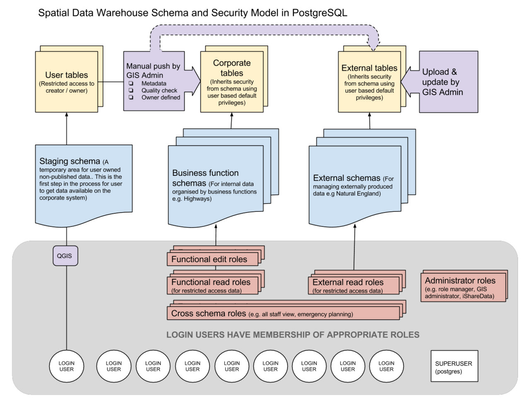iShare Spatial Data Warehouse - SDW
Introduction
The iShare Spatial Data Warehouse (SDW) enables the sharing of spatial data at multiple levels across an enterprise and beyond. This may range from high level ‘super users’ of professional GIS to users across an intranet using a browser based GIS, to citizens at home using a web map portal to search for information. Astun offer a fully fledged Open Source solution that delivers considerable savings in licenses, maintenance and support.
iShare SDW can be deployed as the master data repository for all spatial data with iShare GIS and desktop clients (e.g. QGIS, MapInfo Professional, CadCorp and ArcGIS) reading from and writing to the same database.
Additionally iShare SDW combined with iShare Studio can harvest tabular and spatial data from other back office systems and external sources and where necessary process that data for presentation to desktop and web clients (e.g. spatialise by joining with AddressBase, BoundaryLine or ONS boundaries).
iShare SDW is built upon PostgreSQL/PostGIS with a customised design to suit our typical clients. Our spatial data warehouse contains a security model to accommodate external datasets, internal datasets, personal and restrictive data. The SDW also supports auditing of any spatial layer. Auditing allows the GIS staff to rollback any changes to a dataset and to produce epoch views of any given dataset within the SDW.
iShare SDW Key Benefits:
- Extends PostGIS to a full Spatial Data Warehouse
- Manage data access for desktop and web clients
- Access by multiple GIS clients e.g. MapInfo, ArcGIS and Cadcorp
- Publish data to and from back office systems by scheduling advanced workflows to extract, transform and load data
- Transformations can include anonymisation, aggregation, filtering, aliasing and geocoding
- Audit usage and changes to datasets with the option to create a snapshot at a specific date.
- Fine grain role based security
- Reporting functionality i.e. ability to create reports on valid features, users with access, tables with auditing applied
A Brief Outline
Users & Roles
V2.0
The GIS staff will act as the administrator of the SDW; they will be assigned a role called 'sdw_admin'.
All staff members will assigned a role called 'sdw_staff'.
Staff members can create data in the schema called 'staging'. Consider it a scribble-pad area. By default users can only see their own data in this area. Once data is ready for corporate consumption SDW admin staff will move data tables from 'staging' to another schema. Schemas can be set up for projects or departments.
Schemas are the key to the security model. All tables and views within a schema are owned by the schema_owner role. Editing rights to tables are owned by the schema_editor role and read access is controlled by the schema_viewer role. If the schema has been created with corporate access (think public) in mind then read access is also permitted by the sdw_staff role by giving them schema_viewer role.
V1.5
The GIS staff will act as the administrator of the SDW; they will be assigned a role called 'admin'.
All staff members will assigned a role called 'staff'.
Staff members can create data in the schema called 'staging'. Consider it a scribble-pad area. By default users can only see their own data in this area. Once data is ready for corporate consumption SDW admin staff will move data tables from 'staging' to another schema. Schemas can be set up for projects or departments.
Schemas are the key to the security model. All tables and views within a schema are owned by the schema_owner role. Editing rights to tables are owned by the schema_editor role and read access is controlled by the schema_viewer role. If the schema has been created with corporate access (think public) in mind then read access is also controlled by the staff role.
Can data be created in the Public schema?
No, the security model does not permit users to create data in the public schema. It is possible for a superuser to migrate data to the public schema although it is not encouraged.
Software Familiarisation
It is important that the admin staff members are familiar with Astun's iShare Studio and pgAdmin3 - the client interface for PostgreSQL databases. They should be able to create Workflow Connections and Workflow Tasks in Studio.
